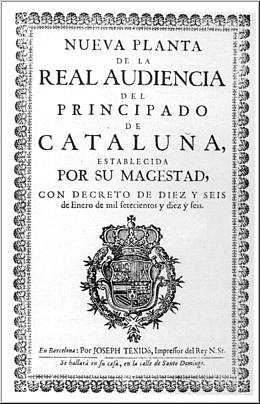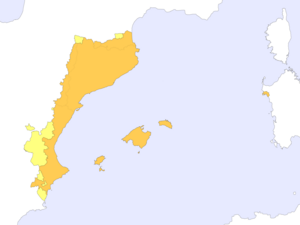History of Catalan facts for kids
The Catalan language started in the Pyrenees Mountains between France and Spain. It grew from the everyday Latin spoken by people long ago. Around the 9th century, Catalan began to become different from other Romance languages like Spanish or French.
As Catalan counts (leaders) took over land from Muslims in the Iberian Peninsula, the Catalan language spread quickly. By the 11th century, you could find Catalan in many important documents. By the 15th century, Catalan was used all over the Mediterranean Sea, especially when the city of Valencia was very successful.
In 1659, the Treaty of the Pyrenees was signed. This agreement started a time when the Catalan language was not allowed in some places. King Louis XIV of France made a rule that stopped people from using Catalan in Northern Catalonia. This ban continued during the French Revolution, when the French government stopped Catalan from being taught. This unfair treatment lasted a long time. But in 2007, the government in the Pyrénées-Orientales region finally said that Catalan could be used in public and in schools again.
In Spain, Catalan was also not allowed in official places for a while. It became official again when Catalonia had its own government from 1931 to 1939. But during the time of Franco (1939-1975), Catalan was banned in government and schools. People were also told not to use it in public. At first, it was not allowed in TV or radio, but by the 1950s, people could publish books in Catalan. After Franco died, Spain became a constitutional monarchy. Catalan became an official language again and is now supported by local governments in areas where it is spoken, like Catalonia, the Balearic Islands, and Valencia. Even with these efforts, Catalan still faces challenges today.
Contents
Catalan in the Middle Ages
How Catalan Started
By the 9th century, the Catalan language had grown from everyday Latin. It developed on both sides of the eastern Pyrenees mountains. This included areas like Rosselló, Empúries, and Cerdanya. It also spread south into the Roman province of Tarraconensis. From the 8th century onwards, Catalan leaders moved south and west. They took over lands from Muslims and brought their language with them.
This spread became faster after the County of Barcelona became separate from the Carolingian Empire in 988. By the 9th century, Christian rulers controlled the northern parts of what is now Catalonia. This area is called "Old Catalonia." In the 11th and 12th centuries, they expanded their lands to the north of the Ebro river, known as "New Catalonia." In the 13th century, Catalans expanded even more. They reached the Kingdom of Valencia, the Balearic Islands, and Alghero in Sardinia.
Historian Jaume Villanueva believed the first Catalan sentence was found in an 8th-century paper from Ripoll. This paper is now lost. The sentence was a funny note: Magister m[eu]s no vol que em miras novel (meaning "my master does not want you to watch me, newbie").
From the 9th century, many official papers, like promises and complaints, started to show Catalan words. These papers were mostly in Latin but had Catalan names or even full sentences. For example, in a document from 839 about the cathedral of Urgell, place names clearly show Catalan features. By the middle of the 11th century, documents written mostly or completely in Catalan began to appear. These include the Oath of Radulf Oriol and the Complaints of Guitard Isarn.
Catalan shares many features with languages from France and Northern Italy. Old Catalan became different from Old Occitan between the 11th and 14th centuries. However, it was not until the 19th century that Catalan was officially seen as a separate language. In 1863, a German language expert named Friedrich Christian Diez said Catalan was as important as other Romance languages. He still noted its close link to Occitan.
Golden Age of Catalan
Catalan had a "golden age" in the Late Middle Ages. This was a time when the language and culture were at their best. You can see this in the writings of Ramon Llull (1232–1315) from Majorca. Also, the Four Great Chronicles (from the 13th-14th centuries) and the poetry from Valencia, especially by Ausiàs March (1397–1459), show this.
By the 15th century, the city of Valencia was a very important center for culture and society. Catalan was spoken all over the Mediterranean world. People believed that a strong government meant a strong language. So, the Royal Chancery (a government office) worked to make Catalan a very standard language.
The famous adventure novel Tirant lo Blanc (1490) by Joanot Martorell shows how ideas changed from the Middle Ages to the Renaissance. This change can also be seen in the works of Bernat Metge. During this time, Catalan was considered "one of the 'great languages' of medieval Europe." The Renaissance period also saw the invention of the printing press. The first book printed with movable type in Spain was in Valencia in 1474. It was called Trobes en llaors de la Verge maria ("Poems of praise of the Virgin Mary").
Catalan from the 18th Century to Today: France
After the Treaty of the Pyrenees, King Louis XIV of France issued a royal order on April 2, 1700. This order banned the use of Catalan in what is now Northern Catalonia. The order said that any official document not in French would not be valid.
Soon after the French Revolution, the French government banned official use of languages other than French. These included Catalan, Breton, and Basque. They called these languages patois, meaning local dialects.
This effort to get rid of non-French languages was made official in 1794. A report said it was necessary to destroy these local languages. It aimed to make French the only language used everywhere. After this, all languages except French were banned in government and schools. This was done to unite France after the revolution.
Even today, the French government only recognizes French as the country's official language. However, on December 10, 2007, the local government of the Pyrénées-Orientales region recognized Catalan. They said Catalan was one of the official languages of their department. They also wanted to help promote it in public life and education.
Their rule states: "The General Council of Pyrénées-Orientales officially recognizes, along with the French language, Catalan as a language of the department."
Catalan from the 18th Century to Today: Spain

After the Nueva Planta Decrees, Catalan was banned in government and schools in Spain. However, this ban did not stop people from speaking it in everyday life. In 1807, a French survey found that in Roussillon, almost everyone spoke Catalan. The French consul in Barcelona also said that Catalan was taught in schools. It was printed and spoken by everyone, not just common people. He noted it was spoken everywhere except in royal courts. He also said Catalan was spoken in Valencia, the Balearic Islands, Sardinia, and Sicily.
During a period called the Renaixença, the use of Catalan grew again. When Spain was a republic (1931-1939), Catalan became an official language in Catalonia. It was widely used by the Generalitat de Catalunya, which was Catalonia's self-government.
During Francoist Spain (1939–1975), the government promoted Spanish. They tried to stop people from using Catalan in public. Catalan was banned in government buildings and public events. Later, some traditional or religious events in Catalan were allowed. At first, Catalan was forbidden in TV and radio. But by the early 1950s, plays in Catalan were allowed. Books in Catalan continued to be published. There were attempts to ban spoken Catalan in shops, and all signs and business papers had to be in Spanish.
After Franco died in 1975, Spain became a democracy. The use of Catalan increased a lot. This was because of new rules and support from the government. Catalan became an official language again. It is now used in politics, education, and the media. This includes newspapers like Avui and La Vanguardia. There are also TV channels like TV3 in Catalonia.
Even with more media in Catalan, Spanish is still favored by some laws. This makes Catalan the weaker language. Some groups say that Catalan faces unfair treatment. They also say that some people try to divide the language, which is called "linguistic secessionism."
See also
 In Spanish: Historia del idioma catalán para niños
In Spanish: Historia del idioma catalán para niños





